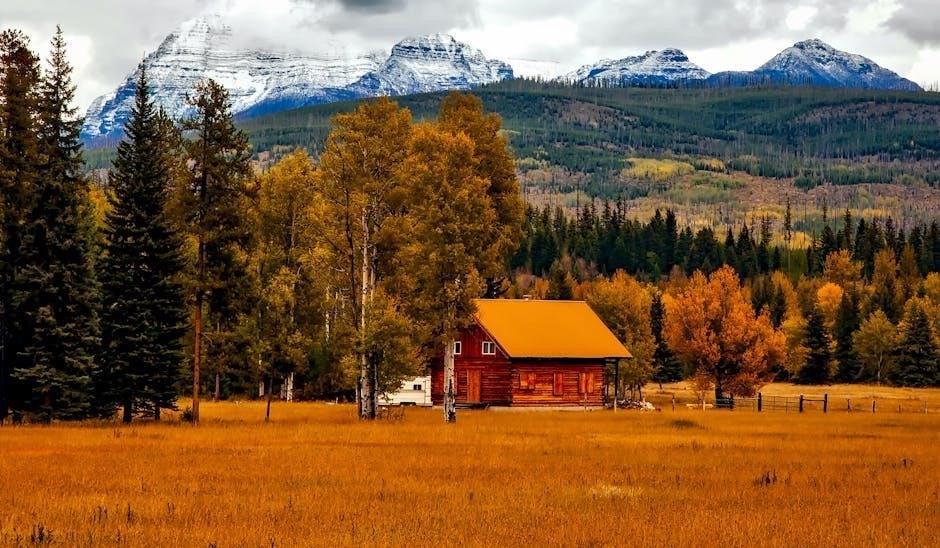Little House in the Big Woods is the first book in Laura Ingalls Wilder’s beloved series, set in 1871 Wisconsin. It introduces Laura’s early life, emphasizing family, resilience, and pioneer spirit, and is available as a free PDF for readers worldwide.
Overview of the Book
Little House in the Big Woods is the first installment of Laura Ingalls Wilder’s iconic series, detailing her childhood in a log cabin on Wisconsin’s frontier. Set in 1871, the story follows four-year-old Laura and her family as they navigate pioneer life. The book vividly describes their daily routines, challenges, and joys, offering a glimpse into 19th-century American settlers’ lives. Themes of family, resilience, and self-sufficiency shine through, making it a timeless tale. The PDF version is widely available for free, allowing readers to explore this cherished classic effortlessly, ensuring its enduring appeal across generations.
Historical Context of the Story
Little House in the Big Woods is set in 1871, during the post-Civil War era, when American pioneers like the Ingalls family were settling across the Midwest. The story reflects the challenges and simplicity of frontier life, showcasing self-sufficiency and resilience. The book offers a glimpse into the daily struggles and joys of settlers in Wisconsin’s Big Woods, highlighting their reliance on nature and family bonds. This historical context is vividly portrayed in the free PDF version, allowing readers to explore the experiences of early American settlers and their way of life during this pivotal era.
Significance of the Title
The title Little House in the Big Woods captures the essence of the Ingalls family’s life in a small log cabin surrounded by vast, dense forests in Wisconsin. The “little house” symbolizes warmth, safety, and closeness of family, while the “big woods” represent the vast, untamed wilderness. The title reflects the contrast between the comfort of home and the challenges of frontier life. This theme is beautifully illustrated in the free PDF version, offering readers a glimpse into Laura’s childhood and the enduring spirit of pioneer life.

Author Background
Laura Ingalls Wilder, a former teacher and journalist, drew from her childhood experiences to craft the Little House series. Her writing career began later in life, with Little House in the Big Woods published in 1932, becoming an instant success. The free PDF version of her work continues to share her pioneering spirit with readers worldwide.
Laura Ingalls Wilder’s Early Life
Born in 1867 near Pepin, Wisconsin, Laura Ingalls Wilder grew up in a family of pioneers, experiencing a childhood shaped by the challenges and beauty of the American frontier. Her early life in the Big Woods, surrounded by dense forests and wildlife, deeply influenced her writing. Laura’s education began at home, with her parents fostering a love for storytelling and learning. She later became a teacher and married Almanzo Wilder, eventually channeling her life experiences into the Little House series. The free PDF of Little House in the Big Woods captures her vivid memories of this formative period, offering readers a glimpse into her extraordinary childhood and the roots of her literary legacy.
Inspiration Behind the Little House Series
Laura Ingalls Wilder drew inspiration for the Little House series from her childhood experiences as a pioneer girl. Her family’s journeys, struggles, and everyday life in the American frontier shaped the stories. The series reflects her deep connection to her parents, who instilled in her a love for nature, resilience, and storytelling. Wilder wrote the books later in life, recalling vivid memories of her youth. The first book, Little House in the Big Woods, captures her early years in Wisconsin, offering a heartfelt portrayal of family life. The free PDF version allows readers to explore this timeless tale of pioneer spirit and enduring values.
Writing Style and Technique
Laura Ingalls Wilder’s writing style in Little House in the Big Woods is simple yet engaging, reflecting her childhood perspective. She uses vivid imagery and dialogue to immerse readers in pioneer life. The narrative flows naturally, capturing the rhythm of daily routines and the beauty of the frontier. Wilder’s ability to convey complex emotions through straightforward language makes the story accessible to all ages. Her technique of focusing on small, meaningful moments creates a sense of intimacy and authenticity. The free PDF version preserves this timeless storytelling, allowing readers to connect with her enduring legacy. Her writing remains a cornerstone of American literature.

Setting of the Story
Little House in the Big Woods is set in 1871 Wisconsin, nestled in the Big Woods. The story unfolds in a cozy log cabin surrounded by dense forests, highlighting the Ingalls family’s secluded yet vibrant pioneer life. This setting, available in a free PDF, vividly portrays their close-knit family life and connection to nature.
Geographical Location: The Big Woods of Wisconsin
The story is set in 1871 in the Big Woods of Wisconsin, where the Ingalls family lives in a cozy log cabin. Surrounded by dense, towering trees, the cabin is nestled deep within the forest, creating a secluded yet vibrant environment. The Big Woods serve as a central backdrop, showcasing the family’s connection to nature and their pioneer lifestyle. This setting, detailed in the free PDF version of the book, highlights the family’s resourcefulness and harmony with their natural surroundings, making it a pivotal element of the narrative.
Time Period: 1871
The story unfolds in 1871, a pivotal year in American history, as the nation recovered from the Civil War and westward expansion began. Laura Ingalls, just four years old, experiences the simplicity and challenges of pioneer life. The free PDF version captures the essence of this era, detailing the family’s log cabin, hunting trips, and farming activities. This time period highlights the Ingalls family’s resilience and resourcefulness, offering a glimpse into the lives of early American settlers. The setting of 1871 is central to the story’s charm and historical significance.
Description of the Little Log Cabin
The little log cabin, nestled on the edge of the Big Woods, was a cozy, gray house made of logs. It featured a thatched roof, a small loft for sleeping, and a central fireplace for warmth and cooking. The interior was simple, with a table, chairs, and a chest for storing provisions. The cabin was surrounded by towering trees, creating a sense of isolation yet closeness to nature. This humble home, as depicted in the free PDF version, symbolizes the Ingalls family’s self-sufficient lifestyle and their deep connection to the wilderness.

Main Characters
The story centers around Laura, a curious four-year-old, her kind father Pa, gentle mother Ma, and sisters Mary and Carrie living in the Big Woods.

Laura Ingalls
Laura Ingalls, the protagonist, is a spirited and curious four-year-old girl living in the Big Woods of Wisconsin. She narrates the story, offering a child’s perspective on pioneer life. Her curiosity and imagination drive her interactions with the world around her. Laura’s relationship with her family, especially her parents, is central to the narrative. Her father, Pa, inspires her with stories and music, while her mother, Ma, teaches practical skills. Laura’s character embodies the resilience and adaptability of a child growing up in a challenging yet loving environment, making her relatable and endearing to readers.
Pa Ingalls
Pa Ingalls, Laura’s father, is a kind, hardworking man who provides for his family in the Big Woods. He is skilled in hunting, farming, and music, often playing the fiddle to entertain his family. Pa’s storytelling and wisdom shape Laura’s understanding of the world. His strength and resourcefulness are vital to the family’s survival, while his gentle nature makes him a loving father figure. Pa’s character represents the resilience and adaptability of pioneer life, making him a central figure in Laura’s early years and the story’s narrative.
Ma Ingalls

Ma Ingalls is the loving matriarch of the Ingalls family, known for her kindness, patience, and strong character. She manages the household with skill, ensuring the family is well-fed and cared for. Ma is a practical woman who values hard work and cleanliness, teaching Laura and her sisters important life skills. Her calm demeanor provides stability, while her love for her family strengthens their bond. Ma’s role in the story highlights the importance of women in pioneering families, showcasing her as a pillar of strength and nurturing care in the Big Woods.
Mary and Carrie Ingalls
Mary and Carrie Ingalls are Laura’s older and younger sisters, respectively. Mary, known for her gentle and kind nature, plays a nurturing role, often helping Laura feel secure. Carrie, though younger, displays a lively and curious spirit, adding energy to the household. Both sisters contribute to the family’s well-being, learning essential skills from their parents. Their bond with Laura highlights the importance of sibling relationships in the story. Together, they embody the resilience and adaptability of the Ingalls family, thriving in the challenging yet beautiful Big Woods environment.

Themes of the Book
The book explores themes of family values, showcasing the Ingalls’ close-knit relationships and mutual support. It emphasizes resilience and self-sufficiency, highlighting their ability to thrive in challenging frontier life.
Family Values
Family values are central to Little House in the Big Woods, portraying the Ingalls family’s deep bond and reliance on one another. The story highlights their collaborative efforts in daily life, such as preparing food and celebrating special occasions. Pa’s leadership, Ma’s nurturing, and the sisters’ camaraderie illustrate strong familial ties. These values are shown through shared responsibilities and mutual respect, emphasizing the importance of family unity in overcoming challenges. The PDF version of the book further underscores these themes, making them accessible to readers worldwide.
Resilience and Adaptability
Little House in the Big Woods showcases the Ingalls family’s resilience and adaptability as they navigate life in the wilderness. Facing challenges like harsh winters and isolation, they rely on resourcefulness and teamwork. Laura and her sisters learn to make do with what they have, from crafting toys to preserving food. The family’s ability to adapt to their surroundings and overcome difficulties highlights their strength and determination. These qualities are central to the story, inspiring readers to embrace resilience in their own lives. The PDF version of the book offers a firsthand look at these themes.
Self-Sufficiency and Hard Work
Little House in the Big Woods emphasizes the Ingalls family’s self-sufficiency and hard work as they thrive in the wilderness. They grow, hunt, and preserve their own food, relying on their skills to survive. Laura learns the value of contributing to the household, from churning butter to helping with chores. The family’s ability to be self-reliant and work diligently is a core theme, reflecting the pioneer spirit. The PDF version of the book highlights these traits, showcasing how their hard work and resourcefulness sustain them through challenging times.

Key Events and Chapters
Little House in the Big Woods follows Laura’s childhood in 1871 Wisconsin, detailing her family’s daily life, from making butter to hunting, and the lessons learned through these experiences.
Little House in the Big Woods introduces readers to pioneer life in 1871 Wisconsin through Laura’s experiences. The story details daily activities like farming, hunting, and food preservation, showcasing the Ingalls family’s self-sufficiency. Laura learns essential skills, such as churning butter and smoking meat, highlighting the resourcefulness of pioneer families. The book vividly portrays the challenges and joys of living in a remote wilderness, offering a glimpse into a bygone era. The PDF version of this timeless tale is widely available for free, making it accessible to readers worldwide.
Challenges Faced by the Ingalls Family
The Ingalls family faced numerous challenges living in the remote Big Woods of Wisconsin. Isolation was a constant struggle, with neighbors far away and limited access to supplies. Harsh weather conditions, like freezing winters, demanded resilience and resourcefulness. Economic difficulties also loomed, as the family relied on Pa’s hunting and farming to survive. Despite these hardships, the Ingalls family thrived through teamwork and adaptability, teaching Laura valuable lessons about perseverance. The PDF version of the book offers a detailed glimpse into their courageous pioneer life, highlighting their strength in the face of adversity.
Important Lessons Learned
In Little House in the Big Woods, Laura learns valuable lessons about resilience, adaptability, and the importance of family unity. She discovers the significance of hard work and self-sufficiency, as her parents teach her essential survival skills. The story emphasizes gratitude for simple blessings and the strength found in overcoming challenges together. These lessons are vividly portrayed in the PDF version of the book, offering readers insights into pioneering life and the enduring values of Laura’s upbringing, which shaped her character and outlook on life.

Educational Resources
The Little House in the Big Woods PDF is widely available for free, offering a convenient way to access the book. Additionally, unit studies, worksheets, and teaching guides provide engaging ways to explore the story, making it a valuable resource for both classrooms and homeschooling environments.
Free PDF Availability
The Little House in the Big Woods PDF is widely available for free download, enabling readers to access the book effortlessly. Platforms like FlipBuilder and issuu.com offer the PDF for free, while libraries provide borrowing options. The eBook is also accessible through online readers, making it easy to enjoy digitally. Additionally, free unit studies, worksheets, and teaching guides accompany the PDF, enhancing its educational value for classrooms and homeschooling. These resources enrich the reading experience, offering interactive learning opportunities for students of all ages.
Unit Study and Worksheets
A comprehensive unit study for Little House in the Big Woods includes 37 worksheets, each tailored to individual chapters. These resources feature reading comprehension quizzes, word searches, and research activities, fostering engagement and understanding. Perfect for homeschooling or classroom use, the study unit aligns with the book’s themes, enhancing learning through interactive exercises. Available alongside the free PDF, these materials provide educators with a robust toolset to explore Laura’s pioneer life and its historical context, making the learning experience both enjoyable and enriching for students.
Teaching Guides for Classroom Use
Teaching guides for Little House in the Big Woods offer educators a structured approach to integrating the book into classroom curricula. These guides include chapter-by-chapter discussion prompts, historical context activities, and essay questions to deepen students’ understanding of pioneer life. Designed to align with educational standards, they provide insights into Laura’s experiences, fostering critical thinking and engagement. Available alongside the free PDF, these resources empower teachers to create meaningful lessons, enriching students’ connection to the story and its timeless themes of family, resilience, and self-sufficiency.

Cultural Impact
Little House in the Big Woods has left a lasting legacy, inspiring adaptations like the beloved TV series and shaping American literary heritage. Its themes of resilience and self-sufficiency continue to resonate, making it a cherished classic that preserves pioneer values for future generations.
Legacy of the Little House Series
The Little House series, starting with Little House in the Big Woods, has become a cornerstone of American children’s literature. Its enduring popularity lies in its authentic portrayal of pioneer life, timeless values, and Laura’s relatable voice. The series has inspired numerous adaptations, including the iconic TV show, and remains a vital part of educational curricula. The availability of Little House in the Big Woods as a free PDF ensures its accessibility, allowing new generations to discover and cherish Laura’s story, solidifying its legacy as a cultural treasure.
Adaptations and Interpretations
The Little House series, including Little House in the Big Woods, has been adapted into various forms of media. The most notable is the beloved TV series Little House on the Prairie, which brought Laura’s story to life for millions. Additionally, the book has inspired stage productions, audio dramatizations, and educational resources. Its themes and characters have also been interpreted through teaching guides, unit studies, and interactive worksheets. The availability of Little House in the Big Woods as a free PDF and its digitization into flipbooks have further expanded its reach, ensuring its enduring presence in modern media.
Significance in American Literature
Little House in the Big Woods holds a cherished place in American literature, offering an authentic portrayal of pioneer life and childhood experiences. Laura Ingalls Wilder’s vivid storytelling and relatable characters have captivated readers for generations. The book is praised for its historical accuracy and its ability to convey timeless values such as family, resilience, and self-sufficiency. Its enduring popularity has made it a cornerstone of children’s literature, while its themes resonate with audiences of all ages. The availability of Little House in the Big Woods as a free PDF ensures its legacy endures in the digital age.
Little House in the Big Woods remains a timeless tale of pioneer life, offering insights into Laura’s childhood and enduring values. Its availability as a free PDF ensures its legacy for future generations, inspiring readers to explore the entire series and appreciate the richness of American history.
Final Thoughts on the Book’s Importance
Little House in the Big Woods is a foundational piece of American literature, offering a glimpse into pioneer life and timeless values like family, resilience, and self-sufficiency. Its availability as a free PDF ensures accessibility for readers worldwide, preserving Laura Ingalls Wilder’s legacy. The book’s vivid storytelling and historical insights make it a cherished resource for both education and personal enjoyment, inspiring readers to appreciate the simpler, harder yet fulfilling life of early American settlers.
Encouragement to Read the Series
Reading Little House in the Big Woods is just the beginning of an unforgettable journey. The entire series offers a captivating portrayal of Laura Ingalls Wilder’s life, exploring themes of family, resilience, and growth. With the first book available as a free PDF, it’s easy to start the adventure. The series provides invaluable insights into American history and pioneer life, making it a must-read for both children and adults. Dive into the world of the Ingalls family and experience the timeless charm of their story, enriched with lessons that resonate across generations.

No Responses